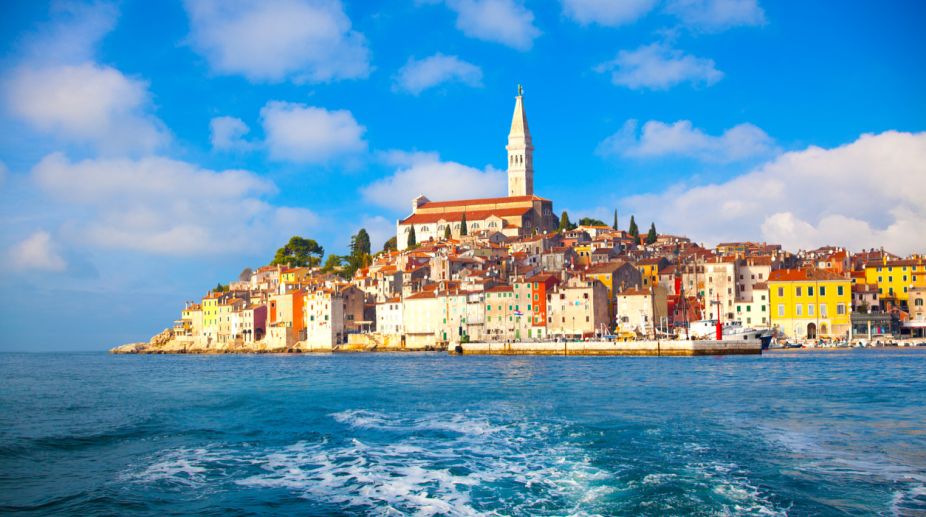Man tries to open airplane door midflight in Croatia
In an unusual incident aboard a Croatian flight, a professional boxer from Britain tried to open the door of the…

old Istrian town in Porec, Croatia (Photo: Getty Images)
Istria is the place where the Mediterranean ascends to the centre of Europe by way of the Adriatic. It is a spectacular Croatian region, a nook rightly called the splendid land or the land of fairies, and terra magica, but also terra incognica, which tourists are rediscovering only recently.
The coast of Istria is recognised as one of the most picturesque locations in the world with a clean sea, diverse marine life and a few beautiful ship relics.
And, unlike those overcrowded and overrated resorts in other West European countries, most of the Adriatic resorts function in perfect harmony between man and the extraordinary surrounding nature.
Advertisement
There the trees still grow luxuriously, birds sing, flowers are fragrant and the virgin sea gently laps the lovely beaches.
One’s hotel room would actually descend gently to the beach, almost touching the endless blue.
The towns along the coast are genuine jewels of Mediterranean architecture.The eternity of ancient Rome, the gracefulness of Venice, the Central European spirit of the Habsburg Monarchy and the spell of the Adriatic — this is the shortest description of the unique bunch of picturesque coastal towns.
Pula is the most southern, most mature, and most beautiful among the bunch of heady and intoxicating Istrian towns. The enchanting sea side retreat is full of historic cultural monuments from the Roman period, two millennia ago. It is studded with landmarks.
All sight seeing usually start from Forum, the oldest square of the town and its nerve centre today.
Just around the corner is the magnificent Temple of Augustus, The Triumphal Arch of the Sergii and the even older city gates and walls.
However, of all such historic sites, the Roman amphitheatre is certainly the most impressive. It is not only the best preserved but one of the most beautiful amphitheatres in the world.
And, it is still being used for major cultural events. Pula is the hub of tourism and economic activity in Istria County. Lying on the opposite shore across the Adriatic is Porec.
It is one of the key towns on the Mediterranean where the Roman urban character is still visible and remains symbolically in the names of its main streets — Decumanus and Cardo Maximus. The most unique monument is Eupharasian Basilica, an early Christian Cathedral, which is now a Unesco-protected World Heritage Site.
Rovinj is a gem of a little town softly embedded in a picturesque Mediterranean bay. The cliff-like structure at the heart of the old town rises directly from the sea and causes it to resemble a stone boat at anchor.
The grand white Baroque church of St Euphamia stands proudly at the summit of the town, overlooking steep, narrow stone streets, squares and the sea.
Just a little away from Rovinj is the Lim Channel. This flooded karst canyon meanders like a fjord for some 12 kms. The whole bay has been proclaimed as “a special maritime nature reserve” and “a protected landscape”.
Today it also has wellknown bed of oysters, which are in great demand. Further north, Vrsar is a millenniaold idyllic resort town of typical Mediterranean smells and colours complete with quaint churches and bell towers atop a hill carpeted with tiny red-roofed cottages. Further north, one would find other magical coastal towns like Novigrad, Umag and Savudria, all well developed and fast becoming a summer time attraction for seekers of sun and sea.
Right next to the older part of each of these towns there is a spacious marina. The harbour promenade, the Riva, is the ideal place to take a relaxing stroll. This is where the tour boats start on their journey of exploration around the Istrian Adriatic Islands. Most popular among those islands is a Croatian jewel called Brijuni Island National Park.
It forms a seven km-long necklace of islands between Pula and Rovinj. Nature, nudged along by man, has created an Eden-like landscape. During the Austro-Hungarian rule in the early half of 20th century, Brijuni was an exclusive European summer paradise.
Then it became President Tito’s private paradise, where he graciously treated visiting heads of state who he particularly liked, topmost among them being Jawaharlal Nehru and Indira Gandhi.
The peerless beauty of the national park of Brijuni is unique in the world. The exploration of the interior of Istria takes one to unique small towns from the Middle Ages arranged on hilltops. Nowhere in the world can one find so many of them in such a small region. Motovun represents the spirit of Croatian legacy and is an important place of national heritage. The woods around the town are well known for its magic mushroom — the truffle.
While Hum is reputed to be the world’s smallest town, Dvigrad is the largest one of ruins. The mummies and relics of saints in the Church of St Blaz in Vodnjan are another unusual attraction.
Buje is most picturesque from down below and has one of the most important cathedrals and bell towers visible from a long distance.
In these towns time seems to have stopped long ago. With its rich flora and fauna, an exotic park, Roman and Byzantine excavations and picture perfect medieval towns, Istria has suddenly become a top tourist destination.
Advertisement